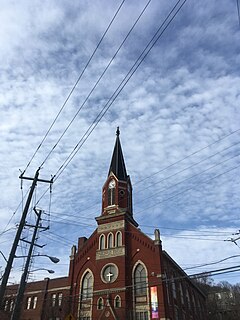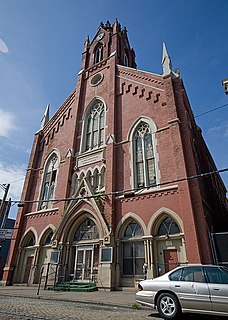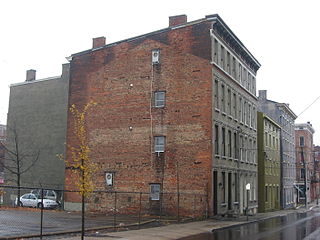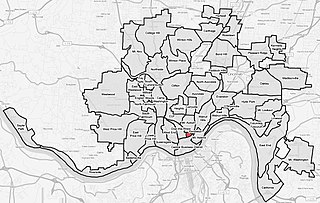
Victorian architecture is a series of architectural revival styles in the mid-to-late 19th century. Victorian refers to the reign of Queen Victoria (1837–1901), called the Victorian era, during which period the styles known as Victorian were used in construction. However, many elements of what is typically termed "Victorian" architecture did not become popular until later in Victoria's reign, roughly from 1850 and later. The styles often included interpretations and eclectic revivals of historic styles (see Historicism). The name represents the British and French custom of naming architectural styles for a reigning monarch. Within this naming and classification scheme, it followed Georgian architecture and later Regency architecture, and was succeeded by Edwardian architecture.

Over-the-Rhine is a neighborhood in Cincinnati, Ohio, United States. Historically, Over-the-Rhine has been a working-class neighborhood. It is among the largest, most intact urban historic districts in the United States.

Know Theatre of Cincinnati is a non-profit theatre company located in the historic Over-the-Rhine neighborhood of Cincinnati, Ohio, which produces contemporary and collaborative theatre that tends to be challenging and thought-provoking. MainStage performances occur in a 99-seat versatile black box theatre. Know Theatre produces a MainStage season, a SecondStage Series, an Educational Series rooted in STEM concepts, and the annual Cincinnati Fringe Festival. In 2010, Know Theatre launched the Jackson Street Market, a series of programs created to provide resources, foster collaborations, and to strengthen the local community of individual artists and independent arts organizations. Its goal is to retain artists in the city and create opportunities for them to make a living from their artistic endeavors. Know Theatre is part of an arts district in Over-the-Rhine with a number of diverse organizations including Art Academy of Cincinnati, Ensemble Theatre Cincinnati, Cincinnati Shakespeare Company, Exhale Dance Tribe, Music Hall.

St. Paul Church is a former Roman Catholic church located on the southeastern corner of Twelfth and Spring Streets in Cincinnati, Ohio, United States, in the city's Pendleton neighborhood.

Old St. Mary's Church is a Roman Catholic church in Cincinnati's historic Over-The-Rhine neighborhood. It is the oldest continually-used house of worship in Cincinnati.

St. Francis Xavier Church is located at 611 Sycamore Street, Cincinnati, Ohio. This was the location of the first diocesan cathedral and the center of early Roman Catholic life in Cincinnati. It was dedicated to St. Peter on December 17, 1826. "Christ Church", the city's first Catholic church was located at Vine and Liberty streets, in the "Northern Liberties" area, at the time outside of the city. A story that the church had to be built on the outskirts of the city because anti-Catholic prejudice prevented a Roman Catholic church within city limits has been shown to be false by church historians. Its frame building was moved on wheels to Sycamore Street in 1826 to serve as the first seminary. Saint Francis Seraph Church now is on the former site, on land purchased from James Findlay.

Mount Auburn Historic District is located in the Mount Auburn neighborhood of Cincinnati, Ohio. It extends along both sides of Auburn Avenue roughly between Ringold Street and William H. Taft Road. The population of Mount Auburn was 4,904 at the 2010 census.

Philippus United Church of Christ is located on the northwest corner of West McMicken and Ohio Avenues, in the Over-the-Rhine neighborhood, in Cincinnati, Ohio. The church is a landmark because of a gilded hand, with its index finger pointing to the heavens, on its tall steeple. The church is an outgrowth of the now-defunct St. Matthews German Evangelical Church at Elm and Liberty Streets, which was a stronghold of "Free" Protestantism. Free Protestantism was very strong in Cincinnati at that particular time. Philippus Church is a red brick church completed in 1891. The church features Gothic Revival-style details. Recessed pointed-arch windows flank the gabled pointed-arch entrance and projecting tower with its rose window. Membership was large from the beginning.

The Hamilton County Memorial Building, more commonly called Memorial Hall, is located at Elm & Grant Streets, in Cincinnati, Ohio. The building is next to Cincinnati's Music Hall and across from Washington Park in the Over-the-Rhine neighborhood. It was built by the Grand Army of the Republic and Hamilton County in 1908, as a memorial to the military of the city and county. The building was built in the Beaux-Arts style. The building, including the Annie W and Elizabeth M Anderson Theater, is used for 300+ events per year.

The former Nast Trinity United Methodist Church, now known as The Warehouse Church, is a historic congregation of the United Methodist Church in Cincinnati, Ohio, United States. Designed by leading Cincinnati architect Samuel Hannaford and completed in 1880, it was the home of the first German Methodist church to be established anywhere in the world, and it was declared a historic site in the late twentieth century.

The Alms and Doepke Dry Goods Company is a historic commercial building in Cincinnati, Ohio, United States. Located along Central Parkway on the edge of downtown, it is a late Victorian structure designed by Samuel Hannaford, a renowned Cincinnati architect.

The Apostolic Bethlehem Temple Church is a historic church building in the Over-the-Rhine neighborhood of Cincinnati, Ohio, United States. A German Gothic Revival structure built in 1868, it was constructed as the home of the German Evangelical and Reformed Church, Cincinnati's oldest German Reformed Church. Founded in 1814, the church changed its name to "St. John's German Protestant Church" in 1874, although it remained in the German Reformed Church. This situation continued until 1924, when it departed for the American Unitarian Association and changed its name to "St. John's Unitarian Church." Little more than twenty years later, the congregation abandoned its old building, leaving it vacant until it was purchased by the present owners, a Pentecostal church.

The Sycamore-13th Street Grouping is a cluster of historic buildings in the Over-the-Rhine neighborhood of Cincinnati, Ohio, United States. Built during the middle and later years of the nineteenth century, these eighteen buildings are built of brick and sandstone with elements of stone and iron. Some of the buildings feature elements of the Greek Revival, Italianate, or Queen Anne styles of architecture, but the majority of the buildings in the cluster are simple vernacular structures. Virtually all of the buildings in the grouping were constructed for residential purposes, although some were built exclusively as apartment buildings, while some originally had both residential and commercial space. The structures built as commercial-and-residential buildings are those most likely to feature defined architectural styles, rather than vernacular designs.

This is a list of the National Register of Historic Places listings in Cincinnati, Ohio.

Pendleton is a small neighborhood in Cincinnati, Ohio, located on the east side of Over-the-Rhine, north of the Central Business District, and south of Mount Auburn. It is home of the Pendleton Art Center. The triangle-shaped boundaries of the neighborhood are Liberty Street, Reading Road/Central Parkway, and Sycamore Street. The population was 900 at the 2010 census.

The School for Creative and Performing Arts (SCPA) is a magnet arts school in Cincinnati in the US state of Ohio, and part of the Cincinnati Public Schools (CPS). SCPA was founded in 1973 as one of the first magnet schools in Cincinnati and became the first school in the country to combine a full range of arts studies with a complete college-preparatory academic program for elementary through high school students. Of the approximately 350 arts schools in the United States, SCPA is one of the oldest and has been cited as a model for both racial integration and for arts programs in over 100 cities.

Frederick W. Garber was an American architect in Cincinnati, Ohio and the principal architect in the Garber & Woodward firm with Clifford B. Woodward (1880–1932). The firm operated from 1904 until it was dissolved in 1933 Their work has been described as in the Beaux-Arts tradition and included buildings on the University of Cincinnati campuses, schools, hospitals, commercial buildings, "fine residences" and public housing.
The history of Over-the-Rhine is almost deep as the history of Cincinnati. Over-the-Rhine's built environment has undergone many cultural and demographic changes. The toponym "Over-the-Rhine" is a reference to the Miami and Erie Canal as the Rhine of Ohio. An early reference to the canal as "the Rhine" appears in the 1853 book White, Red, Black, in which traveler Ferenc Pulszky wrote, "The Germans live all together across the Miami Canal, which is, therefore, here jocosely called the 'Rhine'." In 1875 writer Daniel J. Kenny referred to the area exclusively as "Over the Rhine". He noted, "Germans and Americans alike love to call the district 'Over the Rhine'."
St. Paulus Kirche is a former German Evangelical Protestant church located at the corner of 15th and Race Streets in the Over-the-Rhine historic district of Cincinnati, Ohio. It is one block from the headquarters of 3CDC which are located in Saengerhalle. Built in 1850, it is the oldest surviving Protestant church in the city and the second oldest church in Cincinnati.


















